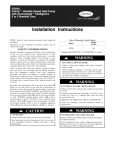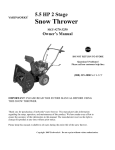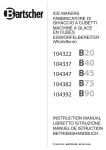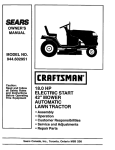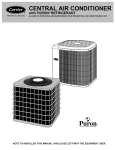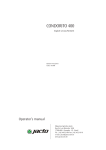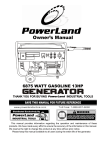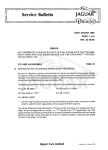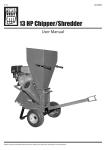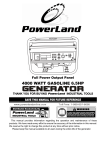Download WEN POWER Power Pro 5.5 HP OHV Owner`s manual
Transcript
5.5 HP OHV HORIZONTAL SHAFT ENGINE i Item # 56055 Owner's Manual DO NOT RETURN Questions? Please call our TO Problems? customer (888) 315-3080 help line: M-F 84 CT Thank you for purchasing this engine. Keep this owner's manual handy, so you can refer to it at any time. This owner's manual is considered a permanent part of the engine and should remain with the engine if resold. The information and specifications included in the publication were in effect at the time of printing. 29 STORE 5.5 HP OHV HORIZONTAL SHAFT ENGINE IDEAL FOR: • Go Karts • Generators • Pumps • Compressors • Small Construction Equipment • ...And More! Notice Regarding Emissions Engines that are certified to comply with U.S. EPA emission regulations for SORE (Small Off Road Equipment), are certified to operate on regular unleaded gasoline, and may include the following emission control systems: (EM) Engine Modifications and (TWC) Three-Way Catalyst (if so equipped). TABLE OF CONTENTS GENERAL ENGINE SAFETY PROCEDURES COMPONENTS PREPARING Using THE ENGINE 7 FOR USE ............................................................... 8 8 8 .................................................................................... 9 ....................................................................................................... Fuel Valve Throttle BEFORE 4 the Engine for the First Time .................................................................. Add Oil ........................................................................................... Add Gasoline CONTROLS ........................................................................ ..................................................................................... 9 Lever ........................................................................................ 9 Lever ........................................................................................... 10 Engine Switch ........................................................................................... Choke Lever ............................................................................................. 10 10 Recoil 11 Starter Handle OPERATING Check the General Check the Engine Check OPERATION ................................................................................... ......................................................................................... Condition of the Engine 11 ......................................................... ....................................................................................... 12 the Equipment Powered By This Engine .................................................... ..................................................................................................... Safe Operating Precautions ............................................................................ Starting the Engine ...................................................................................... STOPPING THE ENGINE ..................................................................................... MAINTENANCE / CARE ..................................................................................... Refueling Engine Check 12 12 12 12 14 15 ................................................................................................. Oil Level 12 16 ................................................................................ 17 Engine Oil Change ...................................................................................... Air Filter Maintenance ................................................................................. 18 19 Sediment ................................................................................ 20 Spark Plug Maintenance ............................................................................... STORING YOUR ENGINE .................................................................................... 21 22 Storage Cup Cleaning Preparation ..................................................................................... 22 Cleaning .................................................................................................. Fuel ........................................................................................................ 22 22 Adding 23 A Fuel Stabilizer to Extend Fuel Storage Life ............................................. Draining the Fuel Tank Carburetor ................................................................... Storage Precautions ..................................................................................... REMOVAL FROM STORAGE ............................................................................... TRANSPORTING CARBURETOR 23 24 24 ............................................................................................... MODIFICATION TROUBLESHOOTING FOR HIGH ALTITUDE OPERATION ......................................................................................... 25 ........................... 25 26 SPECIFICATIONS .............................................................................................. EXPLODED VIEW AND PARTS LIST ..................................................................... 27 28 WARRANTY 31 ..................................................................................................... GENERAL SAFETY PROCEDURES Please familiarize yourself with the following safety symbols and words: The safety alert symbol A is used with one of the safety words (DANGER, CAUTION, or WARNING) to alert you to hazards. Please pay attention to these hazard notices both in this manual and on the engine. DANGER: Indicates a hazard that will result in serious injury or death if instructions are not followed. WARNING: Indicates a strong possibility of causing serious injury or death if instructions are not followed. CAUTION: Indicates a possibility of personal injury or equipment damage if instructions are not followed. O If you have manual any questions or on the product, regarding please the hazard call (888) and 315-3080 safety M-F notices 8-5CT listed before in this using the engine. A DANGER: This engine produces poisonous carbon monoxide gas when running. This gas is both odorless and colorless. Even if you do not see or smell gas, carbon monoxide may still be present. Breathing this poison can lead to headaches, dizziness, drowsiness, and eventually death. • Use outdoors ONLY in non-confined areas. • Keep several feet of clearance engine.. _k WARNING: State of California The exhaust from to cause cancer, on all sides to allow proper ventilation this product birth defects, contains or other chemicals of the known reproductive to the harm. WARNING: This engine may emit highly flammable and explosive gasoline vapors, which can cause severe burns or even death. A nearby open flame can lead to explosion even if not directly in contact with gas. • Do not operate near open flame. • Do not smoke near engine. • Always operate on a firm, level surface. • Always turn engine off before refueling. Allow engine to cool for at least 2 minutes before removing fuel cap. Loosen cap slowly to relieve pressure in tank. • Do not overfill gas tank. Gas may expand during operation. Do not fill to the top of the tank. A • • • Always check for spilled gas before operating. Empty gasoline tank before storing or transporting the engine. Before transporting, turn fuel valve to off and disconnect spark plug. A WARNING: This engine produces heat when running. Temperatures near exhaust can exceed 150°F (65 ° C). • Do not touch hot surfaces. Pay attention to warning markings on the engine denoting hot parts of the machine. • Allow engine to cool several minutes after use before touching areas that heat during use. Owner • • • responsibilities The engines are designed to give safe and dependable service if operated according to instructions. Read and understand this owner's manual before operating the engine. Failure to do so could result in personal injury or equipment damage. Know how to stop the engine quickly, and understand the operation of all controls. Never permit anyone to operate the engine without proper instructions. Do not allow children to operate the engine. Keep children and pets away from the area of operation. Other Equipment Review the instructions provided with the equipment powered by this engine for any additional safety precautions that should be observed in conjunctions with engine startup, shutdown, operation, or protective apparel that may be needed to operate the equipment. Engine Safety Labeling In addition to the above safety hazard markings on the engine notices, please familiarize yourself as shown on the next page. with the safety and ENGINE COMPONENTS Please fiamiliarize yourself with the locations and functions of the various components and controls of your engine. 0 5 9 2 I1 7 (1) Air cleaner- removable and cleanable sponge and paper element that limit the amount of dirt pulled into the engine. (2) Fuel Valve Lever- Controls flow of fuel into the engine. (3) Choke lever- Adjusts the alnount of air let into the engine. (4) Spark plug- Provides proper engine ignition. (5) Muffler- Reduces engine noise. (6) Throttle Lever- Use to control engine speed. (7) On/Off Switch- Used to start/stop engine. -I2 (8) Recoil Starter Handle- Pull-cord for starting engine. (9) Fuel Cap- Access to the fuel tank for adding fuel. (10) Fuel Tank- Stores gas used to run engine. (11) Oil Fill and Dipstick- Location for checking and filling engine oil. (12) Oil Drain Plug- Location for draining oil. PREPARING Using the Engine The following first-time use. to perform for the First Time section If after of the steps please these THE ENGINE FOR USE describes reading steps you this" section, 315-3080 call (888) steps properly must follow to prepare you are unsure about your engine or shorten engine how to perform M-F 8-5 CT for customer can damage your service. for any Failure its"life. If you are using the engine for the first time, there are a few steps you must take to prepare it for operation: Add Oil The engine requires engine oil to operate properly. The engine, when new from the carton, contains no oil in the crankcase. You must add the proper amount ofoil before operating the engine for the first time. This amount, which is equal to the oil capacity of the crankcase, is 20.2 fluid oz. For general use, we recommend SAE 10W/30 oil to fill the engine crankcase. To add 1. 2. 3. 4. oil, follow these steps: Make sure the engine is on a level surface. Unscrew the oil filler/dipstick cap from the engine as shown in figure 1. Using a funnel, add 20.2 fluid ounces ofoil into the crankcase. You will know the crankcase is full when the oil level has reached the lower lip of the opening you have just poured the oil into (see figure 2). Replace oil filler cap. _iLLER Figure CAFTDiPST_CK 1- Unscrewing the oil cap Figure 2- Adding oil Add Gasoline A WARNING: Gasoline and gas fumes are highly flammable. • Do not fill tank near an open flame. • Do not overfill. Always check for fuel spills. To ensure that the engine runs smoothly use only FRESH, U_,,TLEADED GAS WITH AN OCTANE RATING OF 87 OR HIGHER. To add gasoline: 1. Make sure the engine is on a level surface. 2. Unscrew gas cap and set aside (NOTE: the gas cap may be tight and hard to unscrew). 3. Slowly add unleaded gasoline to the fuel tank. The capacity of the gas tank is 0.95 gallons. Be careful not to overfill. NOTE: Gas can expand. Do not fill the gas tank to the very top. 4. Replace fuel cap and wipe up any spilled gasoline with a dry cloth. IMPORTANT: • • • • Never use an oil/gasoline mixture. Never use old gas. Avoid getting dirt or water in the fuel tank. Gas can age in the tank and make it hard to start up the engine in the future. Never store engine for extended periods of time with fuel in the tank. CONTROLS Fuel • • • Valve Lever The fuel valve opens and closes the line between the fuel tank and the carburetor. The fuel valve lever must be in the ON position for the engine to run. When the engine is not in use, leave the fuel valve lever in the OFF position to prevent carburetor flooding and to reduce the possibility of fuel leakage. OFF OFF Figure 3- Fuel Valve Lever Throttle • • Lever The throttle lever controls engine speed. Moving the throttle lever in the directions faster. shown makes the engine run slower or LEVER SLOW Figure 4- Throttle Engine • • • Lever Switch The engine switch enables and disables the ignition system. The engine switch must be in the ON position for the engine to run, Turning the engine switch to the OFF position stops the engine. ENGINE SWITCH OFF Figure 5- Engine Switch Choke Lever • • • • The choke lever opens and closes the choke valve in the carburetor. The CLOSE position enriches the fuel mixture for starting a cold engine. The OPEN position provides the correct fuel mixture for operation after starting, and for restarting a warm engine. Some engine applications use a remotely-mounted choke control rather than the engine-mounted choke lever shown here. 10 CHOKE LEVER CLO Figure Recoil • Starter 6- Choke Lever Handle Pulling the starter rope handle operates the recoil starter to crank the engine. STARTERROPE HANDLE Figure 7- Starter BEFORE Rope Handle OPERATING For your safety, and to maximize the service life of your equipment, it is very important to take a few moments before you operate the engine to check its condition. Be sure to take care of any problem you find, or have your service center correct it, before you operate the engine. Before beginning your preparation switch is the OFF position. The following ready for engine, 315-3080 use. section If after describes reading or if you are unsure M-F 8-5 CT for checks, be sure the engine is level and the engine steps you this section, about must follow you how to perform customer service. 11 to check discoverproblems that your engine or concerns any of the checks please is with the call (888) Check • • • • the General • • • of the Engine Look around and underneath the engine for signs of oil or gasoline leaks. Remove any excessive dirt or debris, especially around the muffler and recoil starter. Look for any signs of damage Check that all shields and covers are in place and all nuts, bolts, and screws are tightened Check • Condition the Engine Check the engine oil level. Running the engine with a low oil level can cause the engine damage. The Low Oil Automatic Shutoff will automatically stop the engine before the oil level falls below safe limits. However, to avoid the inconvenience of an unexpected shutdown, always check the engine oil before startup. Check the air filter. A dirty air filter will restrict air flow to the carburetor, reducing engine performance. Check the fuel level. Starting with a full tank will help eliminate or reduce operating interruptions for refueling. Check the Equipment Powered by This Engine Review the instructions provided with the equipment powered by this engine for any precautions and procedures that should be followed before the engine startup. OPERATION Safe Operating Before operating PROCEDURES Precautions the engine for the first time, please review the GENERAL and the chapter entitled BEFORE OPERATING. SAFETY Review the instructions provided with the equipment powered by this engine for any safety precautions that should be observed in conjunction with engine startup, shutdown, or operation. Starting the Engine 1. Move the fuel valve lever to the ON position 12 as shown in figure 8. OFF Figure . 8- Fuel Valve Lever To start a cold engine, move the choke lever to the CLOSED position (see figure 9). To restart a warm engine, leave the choke lever in the OPEN position. Some engine applications use a remotely-mounted choke control rather than the engine-mounted choke lever shown here. CHOKE LEVER OPEN CLOS /,,_ Figure . 9- Choke ) Lever Move the throttle lever away from the SLOW position, about 1/3 of the way toward the FAST position (see figure 10). Some engine applications use a remotely-mounted rather than the throttle shown here. THROTTLE LEVER SLOW / Figure 10- Throttle 13 Lever 4. Turn the engine to the ON position (see figure 11). ENGINE SWITCH ON Figure 11- Engine Switch . Operate the starter. Pull the starter handle lightly until you feel resistance, briskly. then pull Gently return the handle to the original position. If the engine does not start up, repeat this step. If the engine still does not start after several sttenpts, please review the troubleshooting section for assistance. Figure . 12- Pulling Recoil Starter Handle If the choke lever has been moved to the CLOSED position to start the engine, gradually move it to the OPEN position as the engine warms up. STOPPING THE ENGINE To stop the engine in an emergency, simply turn the engine switch to the OFF position Under normal conditions, use the following procedure. 1. Move the throttle lever to the SLOW position. 2. Turn the engine switch to the OFF position. 3. Turn the fuel valve lever to the OFF position. 14 MAINTENANCE/CARE Good maintenance is essential also help reduce air pollution. for safe, economical, and trouble-free operation. It will To help you properly care for your engine, the following pages include a maintenance schedule, routine inspection procedures, and simple maintenance procedures using basic hand tools. Other service tasks that are more difficult, of require special tools, are best handled by professionals and are normally performed by a technician or qualified mechanic. The maintenance schedule operate your engine under temperature operation, or maintenance schedule for more frequently. in figure 13 applies unusual conditions, use in unusually wet oil change, air filter, to normal operation conditions. If you such as sustained high-load or highor dusty conditions, perform the routine sediment cup, and spark plug cleaning If you have questions about any of the maintenance manual, please call (888) 315-3080 M-F 8-5CT. procedures listed in this CAUTION: • Never perform maintenance operations • To reduce the possibility of fire or explosion, be careful when working around gasoline. Use only a nonflammable solvent, not gasoline, to clean parts. Keep cigarettes, sparks and flames away from all fuel-related parts. • To ensure the best quality and reliability, use only new, genuine parts or their equivalents for repair or replacement. 15 while the engine is running. Recommended Maintenance Schedule each use Engine oil sheck level Air cleaner "eplace sheck first month or20 hrs every 3 months or 50 hrs every6 months or 100 hrs every year or 300 hrs X slean X "eplace paper Nement X Fuel filter cup slean sheck/clean Spark plug X X X "eplace Gas tank sheck gas level slean X* Idle speed Valve clearance Combustion chamber sheck-adjust X* sheck-adjust X* Slean After every 300 hours* Fuel line Sheck Every 2 years (replace if necessary)* * These items should be serviced by your servicing center unless you have the proper tools and are mechanically proficient. Refer to the manual for service procedures. Figure 13- Recommended maintenance schedule Refueling 1. With the engine stopped, remove the gas cap and check the gas level. Refill the tank if the gas level is low. 2. Refuel in a well-ventilated area before starting the engine. If the engine has been running, allow it to cool. Refuel carefully to avoid spilling fuel. Do not fill above the fuel strainer shoulder. After refueling, tighten the fuel cap securely. Never refuel the engine inside a building where gasoline fumes may reach flames sparks. Keep gasoline away from appliance pilot lights, barbecues, electronic appliances, power tools, etc. Spilled gas is not only a fire hazard spills immediately. but it causes environmental damage. or Wipe up NOTICE: Gasoline can damage paint and plastic. Be careful not to spill when filling your gas tank. Damage caused by gas is not cover under warranty. 16 Figure 14- Adding Gas FUEL _( 'OMMENDA Use unleaded TIONS' gasoline with a pump octane rating of 87 or higher. These engines are certified to operate on unleaded gasoline. Unleaded gasoline produces fewer engine and spark plug deposits and extends exhaust system life. Never use stale or contaminated gasoline or an oil/gasoline mixture. Avoid getting dirt or water in the fuel tank. Occasionally you may hear a light "spark knock" or "pinging" (metallic rapping noise) while operating under heavy loads, this is no cause for concern. If a spark knock or pinging occurs at a steady engine speed, under normal load, change brands of gasoline. If spark knock or pinging persists, see your servicing center. NOTE: Running the engine with persistent spark knock or pinging can cause engine damage. Running the engine with persistent spark knock or pinging is considered misuse, and the Limited Warranty does not cover parts damaged by misuse. Engine Oil Level Check Check the engine oil level with the engine stopped and in a level position. 1. Remove the filler cap/dipstick and wipe it clean (see figure 15). 2. Insert and remove the dipstick without screwing it into the filler neck, Check the oil level shown on the dipstick. 3. If the oil level is low, fill to the edge of the oil filter hole with the recommended oil. 4. Screw in the filler cap/dipstick securely. 17 FILLER CAP/DIPSTICK LOWER Figure 15- Checking NOTE: Running L[MFF Oil the engine with a low level oil can cause engine damage. The Low Oil Automatic Shutoff system will automatically stop the engine before the oil level falls below safe limit. However, to avoid the inconvenience of a shutdown, always check the engine oil level before startup. Engine Oil Change Drain the used oil while the engine is still warm. Warm oil drains quickly and completely. 1. Place a suitable container below the engine to catch the used oil, and then remove the filler cap/dipstick and then drain the plug. 2. Allow the used oil to drain completely, and then reinstall the drain plug, and tighten it securely. • '. / FILLER CAP/ DIPSTICK Figure 16- Draining Oil Please dispose of used motor oil in a manner that is compatible with the environment. We suggest you take the used oil in a sealed container to your local recycling center or service station for reclamation. Do not throw it in the trash, pour it on the ground, or down the drain. 18 3. With the engine in a level position, recommended oil. fill to the outer edge of the oil filler hole with the 4. Screw in the filler cap/dipstick securely. ENGINE OIL RECOMMENDATIONS • Oil is a major factor affecting performance automotive detergent oil. and service life. Use 4-stroke • SAE 10W-30 is recommended for general use. Other viscosities shown in the chart may be used when the average temperature in your area is within the recommended range. • The SAE oil viscosity and service classification are in the API label on the oil container. We recommend that you use API SERVICE Category SE or SF oil. SAE Viscosity Grades -20 0 20 40 60 80 100°F L 2 I _ L ,J J -30 -20 -i0 0 10 28 30 ! 40°C AMBEENT TEMPERATURE Figure Air Filter 17- Oil Recommendations Maintenance Remove the air cleaner cover and inspect the filter. Clean or replace dirty filter elements. Always replace damaged filter elements. A dirty air filter will restrict air flow to the carburetor, reducing engine performance. If you operate the engine in very dusty areas, clean the air filter more often than specified in the MAINTENANCE SCHEDULE. NOTE: Operating the engine without an air filter, or with a damaged air filter, will allow dirt to enter the engine, causing rapid engine wear. This type of damage is not covered by Limited Warranty. To service the air filter, perform the following steps: 1. Remove the wing nut from the air cleaner cover, and remove the air cleaner cover. 19 2. 3. 4. 5. Remove the wing nut from the air filter, and remove the filter. Remove the foam filter from the paper filter. Inspect both air filter elements, and replace them if they are damaged. replace the paper air element at the scheduled interval. Clean the air filter elements if they are to be reused. Always Paper air filter element: Tap the filter element several times on a hard surface to remove dirt, or blow compressed air [not exceeding 30psi] through the filter element from the inside. Never try to brush off dirt; brushing will force dirt into the fibers. Foam air filter element: Clean in warm soapy water, rinse, and allow drying thoroughly. Or clean in nonflammable solvent and allow to dry. Dip the filter element in clean engine oil, and then squeeze out all excess oil. The engine will smoke when started if too much oil is left in the foam. 6. 7. 8. Wipe dirt from the inside of the air cleaner base and cover, using a moist rag. Be careful to prevent dirt from entering the air duct the leads to the carburetor. Place the foam air filter element over the paper element, and reinstall the assembled air filter. Be sure the gasket is in place beneath the air filter. Tighten the air filter wing nut securely. Install the air cleaner cover, and tighten the cover wing nut securely. PA_ER FI_ER ELEMENT FOA_ FtETER ELEMENT Figure Sediment Cup tL WARNING: • • 18- Air Filter Components Cleaning Gasoline and gas fumes are highly flammable. Do not fill tank near an open flame. Do not overfill. Always check for fuel spills. 1. Move the fuel valve to the OFF position, and then remove the sediment cup and Oring. 2. Wash the sediment cup and O-ring in nonflammable solvent, and dry them thoroughly. 3. Place the O-ring in the fuel valve, and install the sediment cup. Tighten the sediment cup securely. 2O 4. Move the fuel valve to the ON position, there is any leakage. and check for leaks. Replace the O-ring if SE© M_NT C.JP Figure Spark Plug 19- Sediment (;up Maintenance The spark plug is important for proper engine operation. intact, free of deposits, and properly gapped. NOTE: An incorrect A good spark plug should be spark plug can cause engine damage. To inspect you spark plug: 1. Disconnect the spark plug wire, and remove any dirt from around the spark plug area. 2. Remove the spark plug with a spark plug wrench. 3. Inspect the spark plug. Replace it if the electrodes cracked or chipped. 4. Measure the spark plug electrode gap with a suitable gauge. The gap should be 0.028 -0.031 in (0.70 - 0.80 mm). Correct the gap, if necessary, by carefully bending the side electrode. 5. Install the spark plug carefully, 6. After the spark plug seats, tighten with a spark plug wrench to compress are worn, or if the insulator is by hand, to avoid cross-threading. the washer. If reinstalling the used spark plug, tighten 1/8 -1/4 turn after the spark plug seats. If installing a new spark plug, tighten 1/2turn after the spark plug seats. NOTE:A loose spark plug can over heat and damage the engine. Over tightening the spark plug can damage the threads in the cylinder 7. Attach the spark plug wire. Recommended spark plugs: F6RTC or other equivalents. 21 head. SPARK PLUG WRENCH (070080 i Figure 20- Removing the Spark Plug STORING Storage 4_ ram} 0,028-0031 :n: Figure 21- Spark Plug Gap YOUR ENGINE Preparation Proper storage preparation is essential for keeping your engine trouble free and looking good. The following steps will keep rust and corrosion from impairing your engine's function and appearance, and will make the engine easier to start after storage. Cleaning If the engine had been running, allow it to cool for at least half an hour before cleaning. Clean all exterior surfaces, touch up any damaged paint, and coat other areas that may rust with a light film ofoil. NOTE • Using a garden hose or pressure washing equipment can force water into the air cleaner or muffler opening. Water in the air cleaner will soak the air filter, and water that passes through the air filter of muffler can enter the cylinder. • Water contacting a hot engine can cause damage. If the engine has been running, allow it to cool for at least half an hour before washing. Fuel Gasoline will oxidize and deteriorate in storage. Old gasoline will cause hard starting and leaves gum deposits that clog the fuel system. If the gasoline in your engine deteriorates during storage, you may need to have the carburetor and other fuel system components serviced or replaced. The length of time that gasoline can be left in your fuel tank and carburetor without causing functional problems will vary with such factors as gasoline blend, your storage temperature, and whether the fuel tank is partially or completely filled. The air in a partially filled fuel tank promotes fuel deterioration. Very warm storage/temperatures accelerate fuel deterioration. Fuel deterioration problems may occur within a few months, or even less if the gasoline was not fresh when you filled the fuel tank. 22 The Limited Warranty does not cover fuel system damage or engine performance problems resulting from neglected storage preparation. You can extend fuel storage life by adding a fuel stabilizer that is formulated for that purpose, or you can avoid fuel deterioration problems by draining the fuel tank and carburetor. Adding a Fuel Stabilizer to Extend Fuel Storage Life When adding a fuel stabilizer, fill the fuel tank with fresh gasoline. If only partially filled, air in the tank will promote fuel deterioration during storage. If you keep a container of gasoline for refueling, be sure that it contains only fresh gasoline. 1. Add fuel stabilizer following the manufacturer's instructions. 2. After adding a fuel stabilizer, run the engine outdoors forl0 minutes to be sure that treated gasoline has replaced the untreated gasoline in the carburetor. 3. Stop the engine, and move the fuel valve to the OFF position. Draining the Fuel Tank Carburetor 1. Place an approved gasoline container spilling fuel. 2. below the carburetor and use a funnel to avoid Remove the carburetor drain bolt and sediment cup, and then move the fuel valve lever to the ON position (see figure 22). FUEL VALVE LEVER ()-RING Figure 22- Draining the Fuel Tank Carburetor. . After all the fuel has drained into the container, reinstall the drain bolt and sediment cup. Tighten them securely. 23 Storage Precautions 1. Change the engine oil. 2. Remove the spark plug. 3. Pour a tablespoon 4. Pull the starter rope several times to distribute 5. Reinstall 6. Pull the starter rope slowly until resistance is felt. This will close the valves so moisture cannot enter the engine cylinder. Return the starter rope gently. of clean engine oil into the cylinder the oil in the cylinder. the spark plug. If your engine will be stored with gasoline in the fuel tank and carburetor, it is most important to reduce the hazard of gasoline vapor ignition. Select a well-ventilated storage area. Avoid any area with a spark-producing electric motor, where power tools are operated. If possible, avoid storage areas with high humidity, corrosion. because that promotes rust and Unless all fuel has been drained form the fuel tank, leave the fuel valve lever in the OFF position to reduce possibility of fuel leakage. Position the equipment so the engine is level. Tilting can cause fuel or oil leakage. With the engine and exhaust system cool, cover the engine to keep out dust. A hot engine and exhaust system can ignite or melt some materials. Do not use sheet plastic as a dust cover. A nonporous cover will trap moisture around the engine, promoting rust and corrosion. REMOVAL Check your engine as described FROM STORAGE in the chapter BEFORE OPERATING. If the fuel was drained during storage preparation, fill the tank with fresh gasoline. If you keep a container of gasoline for refueling, be sure that it contains only fresh gasoline. Gasoline oxidizes and deteriorates over time, causing hard starting. If the cylinders were coated with oil during storage preparation, briefly at startup. This is normal. 24 the engine may smoke TRANSPORTING If the engine has been running, allow it to cool for at least 15 minutes before loading the engine-powered equipment on the transport vehicle. A hot engine and exhaust system can burn you and can ignite some materials. Keep the engine level when transporting to reduce the possibility of fuel leakage. Move the fuel valve lever to the OFF position. CARBURETOR MODIFICATION OPERATION FOR HIGH ALTITUDE At high altitude, the standard carburetor air-fuel mixture will be too rich. Performance will decrease, and fuel consumption will increase. A very rich mixture will also foul the spark plug and cause hard starting. Operation at an altitude that differs form that at which this engine was certified, for extended periods of time, may increase emissions. High altitude performance can be improved by specific modifications to the carburetor. If you always operate your engine at altitudes above 5,000 feet (1,500 meters), have your servicing center perform this carburetor modification. This engine, when operated at high altitude with the carburetor modified for high altitudes use, will meet each emission standard throughout its useful life. Even with carburetor modification, engine horsepower will decrease about 3.5% for each 1,000-foot (300-meter) increase in altitude. The effect of altitude in horsepower will be greater then this if no carburetor modification is made. NOTE When the carburetor has" been modiJied will be too lean for a low altitude for high altitude use. Operation operation, at altitudes' below the air-_lel 5, O00 feet mixture (1,500 meters) with modified carburetor may cause the engine to overheat and result in serious engine damage. For use at low altitudes', have your servicing center return the carburetor to original factol_v specifications. 25 TROUBLESHOOTING IMPORTANT: M-F 8-5. Engine Will Not Start 1. Check control positions If trouble persists please call our customer Solution Cause Fuel valve OFF. Move lever to "ON" position. Shoke OPEN. Move lever to "CLOSED" position unless engine is warm. Turn engine switch to "ON" position. Engine switch OFF. 2. Check fuel. help line at (888) 315-3080 Engine is out of gas. Add gas. Engine is filled with Change the gas in the engine. sontaminated or old _las 3. Check oil. 4. Remove and inspect spark plug. 5. Take engine to an authorized servicing dealer. Engine Lacks Power _ow engine oil level automatic shutoff _=ngaged. Spark plug is dirty, Faulty, or improperly ;lapped. Spark plug is wet _vithgas (flooded _=ngine). Fuel filter clogged, sarburetor *nalfunction, ignition *nalfunction, valve stuck, etc. Fill crankcase with proper oil. Gap, clean, or replace spark plug. Dry and reinstall spark plug. Start engine with throttle lever in the "FAST" position. Replace or repair faulty components as necessary. Cause Solution 1. Check air filter. Filter elements slogged. Clean or replace filter elements. 2. Check Gas Engine is filled with sontaminated or old ;las Change the gas in the engine. 3. Take engine to Fuel filter clogged, Replace or repair faulty components as necessary. an authorized sarburetor servicing center or *nalfunction, ignition refer to manual. *nalfunction, valve stuck, etc. 26 SPECIFICATIONS Engine Type LxWxH (in) 4-Stroke, Overhead 12 x 14-3/8 x 13-3/16 (305mm x 365 mm x 335 mm) 30.8 lbs Dry Weight Displacement Bore x Stroke] Compression Ratio Maximum Valve, Single Cylinder Output Maximum Torque 9.9 cubic in. (163 cubic cm) [2.7 in x 1.8 in (68 mm x 45 mm)] 8.5:1 5.5 HP @ 3600 RPM 6.63 ft. lbs (a) 3000 RPM Engine Oil Capacity 20.2 fl. oz. (0.6 L) Engine Oil Type Fuel Tank Capacity SAE 10W-30, API SE or SF, for general use 0.95 gal (3.6 L) Cooling System Forced air [gnition System P.Y.O. (in) Transistorized Magneto Ignition 2-7/16 x 3/4dia. Tapped 5/16 24 U2',TF P.T.O. Shaft Rotation Counterclockwise (from P.T.O. side) IN: 0.15 (+) 0.02 mm (cold) EX: 0.20 (+) 0.02 mm (cold) Valve Clearance Spark Plug Type Spark Plug Gap F6TC or equivalent 0.028-0.031 Carburetor Idle Speed in (0.70-0.80 1700 (+) 150 rpm 27 mm) > > Item 1 2 3 4 5 6 7 8 9 i0 ii 12 13 14 15 16 i? 18 19 2O 21 22 23 24 25 26 2? 28 29 3O 31 32 33 34 35 36 3? 38 39 4O 41 42 43 44 45 46 4? 48 49 5O 51 52 53 54 55 56 5? Part# 11212 Qty Oil drain plug Washer 13180 1 1 Bearing 6205 Crankshaft oil seal 11100 1 Crankcase 26311 26329 1 1 Regulating Washer 26321 1 Split pin 37810 1 Oil sensor GB5787-86 2 M6×14 25151 25165 1 1 Regulating Washer 25120 1 Regulator 25164 25132 1 1 Snap ring Washer 25131 1 Sleeve GB5787-86 6 M6× 12 bolt 20651 1 Air duct 19721 1 Wind cover 12252 2 M6 X 113 bolt 12218 2 1 Set pin d_ 10X 16 Cylinder head gasket 12253 1 2 Cylinder head Assembly M8 X 34 bolt 34200 1 Spark plug 12256 4 Bolt 12312 1 Cylinder head cover gasket 12310 1 Cylinder head cover assembly 15650 1 Oil plug assembly 15651 15612 1 2 Oil plug Seal 11311 1 Crankcase GB276-89 1 Bearing 11119 1 Crankcase 11118 2 Set pin 15611 1 Oil dipstick 15610 13180 1 1 Oil dipstick assembly Crankshaft oil seal GB5787-86 7 M8 X 32 bolt 11213 GB276-89 12220 12210 sway bar bolt shaft gear assembly cover 6205 gasket 13311 1 Piston 13312 13322 1 2 Piston ring ( II ) Side rail 13321 1 Expander ring ( I ) 13320 1 Scraper 13300 1 Piston ring assembly 13222 2 1 Piston Piston pin clip 1 1 Piston Shank pin Connecting Bolt rod cover 13133 1 2 13130 1 Connecting rod assembly 13118 1 Woo&uffkey 13110 14416 1 2 Crankshaft Lock nut 14413 2 Sleeve 14411 2 Valve 13211 13221 13131 13132 Item 58 59 6O 61 62 63 64 65 66 67 68 69 70 71 72 73 74 75 76 77 78 79 8O 81 82 83 84 85 86 87 88 89 9O 91 92 93 94 95 96 97 98 99 IO0 i01 102 I03 104 I05 106 I07 I08 109 ii0 iii 112 113 Description 2 2 ring set assembly rocker 29 Part# Qty Description 14415 2 Adjusting 14410 2 Valve rocker 14261 Pusher Pusher guide 14250 1 2 14455 2 Tappet 14100 14721 1 1 Camshaft assembly Exhaust valve 14711 1 Intake valve 14755 2 Valve spring 14751 1 Intake valve spring 14757 1 Exhaust 14758 1 Cap 12254 1 Inlet gasket 16141 1 Connecting block 16142 1 Carburetor gasket 17330 1 Air cleaner gasket 16100 17100 1 1 Carburetor assembly Air cleaner GB6177-86 2 M6 nut 16937 2 Pipe clamp 16931 1 Outlet GB5787-86 1 M6 X 22 bolt 16950 1 Connector 16961 GB6177-86 1 2 Packing M6 nut 16916 1 Filter cup 16521 1 Packing 16510 1 Fuel cap 16500 16610 1 1 Fuel cap with assembly Fuel tank 18000 1 Exhaust nmffler 12255 1 1 Exhaust M6 nut gasket GB6177-86 GB5787-86 1 M6×22 19810 1 Crankcase GB5787-86 3 M6 X 8 bolt 19710 27300 1 1 Fan hood assembly Recoil starter GB5787-86 5 M6X 35410 1 Engine switch 27100 1 Recoil starter 32211 Plastic Diode clip 37850 1 1 26410 1 Regulating 26363 1 Back spring 26364 1 Regulating 26341 1 1 Pulling rod Lock bolt GB6177-86 1 1 Regulating M6 nut GB5787-86 2 M6 X 25 screw 27515 1 M14 X 1.5 nut 27370 1 Starting flange 19722 1 Flywheel tim 27500 1 Flywheel 34500 1 Ignition 26362 26331 bolt for valve gap assembly seat valve spring seat pipe ring ring bolt side plate assembly 12 bolt assembly frame assembly spring arm coil assembly NOTES: 30 LIMITED WARRANTY Remember to save your registration Power card. FOR POWER receipt TM ENGINES and to accurately You must provide Pro "_ engines PRO are warranted proof FROM WEN POWER TM Jill out and mail your product of purchase for all warranty to be free from defects in materials work. and workmanship for a period of one (1) year from date of original purchase. Engines used for Commercial or Rental use have a warranty period of 90 days from date of original purchase. Keep purchase receipt and mail in the product registration card for proof of purchase. Power Pro by WEN Power will repair or replace, at its discretion, any part that is proven to be defective in materials or workmanship under normal use during the one (1) year warranty period. Warranty repairs or replacements will be made without charge for parts or labor. Parts replaced during warranty repairs will be considered as part of the original product and will have the same warranty period as the original product. TM TM To exercise the warranty, DO NOT RETURN TO RETAILER. Instead, call the toll free Customer Service number: (888) 315-3080 and you will be instructed on where to take the engine for warranty service. Take the engine and proof of purchase (your receipt) to the repair facility recommended by the Customer Service Representative. The warranty does not extend to engines damaged or affected by fuel contamination, accidents, neglect, misuse, unauthorized alterations, use in an application for which the product was not designed and any other modifications or abuse. Power Pro "_ by WEN Power is not liable for any indirect, incidental or consequential damages from the sale or use of this product. Any implied warranties are limited to one (1) year as stated in this written limited warranty. Some states do not allow the exclusion or limitation of incidental or consequential damages. Some states do not allow limitation on the length of an implied warranty. This warranty gives you specific legal rights, and you may have other rights that vary from state to state. TM Power Pro by Wen Power TM. Elgin, IL 60123. 31 www.wenproducts.com.































